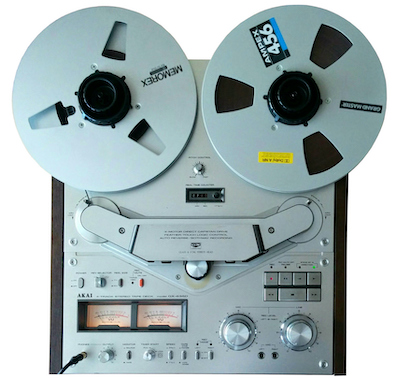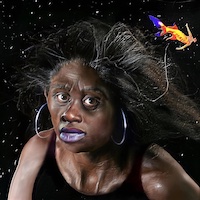Though I no longer earn income writing music criticism (I still earn a bit covering the biz), I find that the annual task of compiling this list has become more and more time consuming, so, in a way, it’s good that I’m semi-retired since it gives me that much more time to waste on it. Then again, once you have time to waste, you end up taking your time, so maybe my notion of cause-and-effect is backwards. In any case, once I did get down to it, I tumbled down the rabbit hole of African electronica, specifically the South African genre called amapiano, which has actually been around for a number of years. I just didn’t know that particular species of house music had a name, but once I did it became like a drug and in mid-November I stopped listening to the stuff I had been listening to regularly all year and dove into it head first, seeking out other writers who knew more about it than I did (thanks, Frank Kogan) and scouring the internet for related artists. Consequently, by mid-December my shortlist was top heavy with African DJs and I wondered if—to beat these metaphors to death—I hadn’t gone overboard. So I’ve spent almost every waking minute of the last three weeks going through all the stuff I’ve liked even glancingly during the past 11 months to make sure I wasn’t overlooking anything, and, as you can probably guess, I found a lot of things I liked that I didn’t expect to. In the end, three amapiano artists remained on the list, and two (DJ Black Low, DJ Finale) were removed, so for once I added a Best Songs list in order to give them—and some other artists I jettisoned—the recognition they deserve.
1. The Candle and the Flame, Robert Forster (Tapete): When he was a Go-Between, Forster obscured his sentimental impulses with an arch performative persona, but now that he’s a senior citizen he can be as mushy as he wants to be about his long marriage, his creative influences (Is “David” Byrne or Bowie?), his late work partner, even his sobriety, however you interpret such a state in these songs. Finding an old ticket stub in a jacket, he isn’t coy about “a reason to live.” He addresses that reason head-on, without fuss and still wielding his talent for angular melodies and stunning rhythmic guitar phrases that convey their own knotty sentiments.
2. The III Wise Men, Felo Le Tee with Mellow & Sleazy (New Money Gang): Though he’s often referred to as a singer-songwriter, Felo Le Tee apparently studied track-making at some kind of DJ institute in South Africa. His meticulous aesthetic makes for airy, laid-back dance music with a robust pulse that’s perfectly suited to sing-songy raps, traditional chanting, and big choruses. Eschewing break beats for jazzy instrumental interplay that folds back on itself, he develops an organic, hypnotic flow that carries the listener from one distinct cut to the next without the slightest threat of techno bruising. I don’t know which guy on the cover is Mellow and what exactly he contributes, but I suspect he’s in charge of the general vibe.
3. My Back Was a Bridge for You, Anohni and the Johnsons (Rough Trade/Beat): Anohni reassembles and augments the estimable Johnsons for what she calls “a blue-eyed soul record” that feels at times more like an exercise in classic rock attitude, especially when she loses that mannered vocal edge of hers and just preaches to the balcony like a possessed Paul Rodgers. It’s an appropriate response to the various deaths she addresses, both human and planetary, and while in the past that mannered edge tended to skirt the celestial here it gives it up to gravity. The trudging blues of “Rest” is as heavy as a mortal sin, the searing guitar struggling to break free of the unspeakable torment of which Anohni sings. If this is the end of the world, she’s going out kicking and screaming.
4. Dens, Lenhart Tapes (Glitterbeat/Rice): Since the turn of the century, brothers Vladimir and Stevan Lenhart have been taking sounds from cassettes found in Belgrade flea markets and turning them into looped beats, but now that they’re working with violinist/vocalist Tijana Stankovic, their music favors real compositional rigor. In fact, some of the selections are based on existing Balkan folk songs that have been passed down for generations, though traditionalists might find them unrecognizable beneath all the industrial grime the Lenharts apply to their tracks. Non-traditionalists like me will just dig the groove. Or the drone. Brothers gonna work it out either way.
5. Autopoiética, Mon Laferte (Universal): Returning to her adopted Mexican base after a brief sojourn in Los Angeles, the Chilean polymath faces her fifth decade on earth with a collection of boleros, sambas, and cumbiana duded up with a full range of available studio affectations in order to put a curse on those who think she’s too old to still be doing this sort of thing. Per the title, music remakes her at the cellular level every time she releases a new album, and this one takes full advantage of her melodramatic vocalese and penchant for over-compensation—no whispery SoCal ambivalence for her. The block rockin’ beats of the title tune imply she’ll live forever, which, as a revenge strategy, is much better than merely living well.
6. Sundae Painters, The Sundae Painters (Leather Jacket): Hamish Kilgour, drummer and leader of the Clean, allegedly assembled this supergroup with members of other New Zealand bands the Bats, Tall Dwarfs, and Toy Love in order to scratch his psychedelia itch. It’s an earnestly rollicking, lo-fi affair, complete with fervent strumming, squalling feedback, and unforced vocals that split the difference between Velvets cool and motorik propulsiveness. The appeal of the music is definitely in the moment. The playing and singing reveal nothing extraordinary on their own, but the group dynamic operates at such a high level of tension and involvement that each new discovery made on the fly kicks the energy up a notch, meaning it’s unreproducible, even if Kilgour were still alive.
7. Crazymad, For Me, CMAT (Cmatbaby): Considering how often her romantic interests turn out to be dead ends on this album, the title baffles me: Who exactly is crazymad for her? Or does that comma indicate a self own? For sure, one of the core attractions of Ciara Mary Alice Thompson’s songwriting is its literary quality, the way her language explains her behavior while deflecting further investigation. She pays “rent for two” in her relationships, and not necessarily figuratively, which makes you question her choices. Anyone who can match melody to metaphor with this kind of facility certainly isn’t crazy, though mad isn’t out of the question; and since I don’t hear a hint of an Irish accent in her lilting, full-bodied soprano I have to wonder how much she puts on for the public. Can’t say I don’t love a mystery.
8. Fountain Baby, Amaarae (Interscope): As with most sexually charged hip-pop today, Amaarae’s hot-blooded material comes across more as stalled fantasy fulfillment than experience-based exposition; which isn’t to say she isn’t getting a lot, only that it’s more fun to sing about getting a lot even if you aren’t. Fortified by the sweetness of her delivery, the songs’ cavalier hedonism embraces contradiction. Money lures that pussy then spoils the party. She’s a god to her lover, but the destroying kind. There are no contradictions in her musical choices. An army of expensive producers and co-writers honor her Ghanian heritage with some of the most compelling Afrobeats of the year while incorporating Beyoncé-worthy R&B style and even guitar punk. She acts as if she deserves it all, and who am I to argue with success?
9. Love in Exile, Arooj Aftab, Vijay Iyer, Shahzad Ismaily (Verve): Improvisational in form, alternately ecstatic and contemplative in effect, Love in Exile works on the idea of true musical collabortion as an unknowable power. Aftab’s Urdu poetry is both divine and romantic, while Iyer’s piano avoids the technical showmanship his jazz playing is famous for. Beneath and surrounding both are Ismaily’s minimalist bass and synth washes. Devoid of ego the music takes on its own indelible personality, expressive without being assertive, but the focus is still Aftab’s voice, which conveys sorrow more than any other emotion, and links the music to a place that sounds South Asian but is clearly located in whichever soul is open to its magic.
10. Sundial, Noname (AWAL): There are lots of adjectives used to describe commercial rap music, but “ecumenical” isn’t a favorite, so while I suppose the inclusive character of Fatimah Warner’s (yes, she does have a name) second album would normally place it outside of the mainstream, it contains enough musical charm and star power to attract the attention of a mainstream audience. The inclusivity, in fact, seems to be the point in that she clearly feels she has to address matters some listeners will find objectionable. So while Jay Electronica is invited to dis the so-called international Jewish conspiracy and $ilkmoney aims his logorrheic flow at other perceived threats he’s read about on Reddit, Noname herself blasts what she construes as normal male behavior on “Toxic” in no uncertain terms. Offended? Fine, but it requires you check your own resentments as well.
Runners-up
–Work of Art, Asake (YBNL Nation): Sales-wise, the biggest amapiano artist in the world, and he’s Nigerian, thus prompting South African practitioners to up their game. Reflexive quality control is the best quality control.
–Ask, Altin Gün (Ato/Rice): Netherlands-based Turkish psych-rockers go all in with the funk in a clear breakout move that succeeds on all levels. Why they aren’t bigger than Khruangbin beats me.
–L’Orchestre National Mauritanien, Ahl Nana (Radio Martiko): The title seems to be a joke since this Berber ensemble contains only four instruments, though the female vocalists can sound mighty symphonic when they want to. Another joke: they recorded this album at the height of their popularity in Casablanca in 1971 and it was never released until now.
–Piano Republik, Major Lazer & Major League Djz (Mad Decent): Not so much a primer for amapiano as a cash-in with stars (Ty Dolla $ign! Tyla! Boniface!), which is great, but the billing should be reversed.
–Spunky!, Grrrl Gang (Kill Rock Stars): Indonesian female-fronted guitar band proves that young adult angst fueled by social media and gender disparity is the universal default mode for indie pop. The fact that they do it better than most proves something completely different.
–Rustin’ in the Rain, Tyler Childers (RCA): Trad trappings + contemporary topics + otherwordly singing = genuine country ca. 2023.
–Integrated Tech Solutions, Aesop Rock (Rhymesayers): Parody makes him a stronger lyricist, experience a fuller musician, intelligence a rapper with few peers.
–Ahora Más Que Nunca, Pelada (New Label): Before anything, punk is about precision, and this Montreal electronica duo dispenses its politically charged Spanish rants as laser beams to the ears. If it hurts, that’s because it’s supposed to.
Favorite Songs
(A note about popular artists that didn’t make my above list but might have made it below: emo has made a concerted comeback in recent years on the charts, often in veiled form. I’ve never liked emo, even when I think its practitioners are talented and have the best intentions.)
-“ETA,” New Jeans
-“Sinatra Drive Breakdown,” Yo La Tengo
-“POS,” Hemlocke Springs
-“The Gods Must Be Crazy,” Armand Hammer (w/Billy Woods, Elucid, El-P)
-“Bad Idea Right?”, Olivia Rodrigo
-“I Saw” and “Drum,” Young Fathers
-“Dumbest Girl Alive,” 1000 Gecs
-“Tiny Garden,” Jamila Woods
-“Lepiano,” DJ Black Low
-“You Can Be Mean,” Indigo De Souza
-“Keeping the Light On,” Joy Oladokun
-“Demons,” Doja Cat











